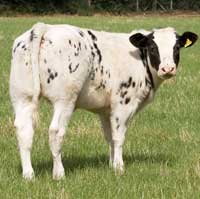Once-bred heifers could help restore beef calf balance

Once-bred heifers could boost suckler herd output by more than 25% a year without increasing cow numbers, says EBLEX’s Duncan Pullar.
“This could help address the continuing imbalance between beef calf demand and domestic supply.
“It is unlikely to adversely affect the eating quality or value of finished heifers and, with good management, should not add significantly to labour or organisational demands,” he says.
About 45 of the 90 live calves produced by a 100-cow herd are heifers, of which 40 will be suitable for breeding. Allowing for 20 herd replacements, this leaves 20 available for once-bred heifer production, resulting in 18 more calves/year.
To achieve the most from once-bred heifer beef it is essential to select well-grown heifer calves at 6-8 months weaning, says Dr Pullar.
“Heifers should be bred at 15 months and 65% of their mature body weight for calving a 24 months and should be put to bulls with EBVs for low birth weight and above-average calving ease.”
Ideally the breeding period for once-bred heifers should be matched with the main herd to ensure foster cows are available. Bred heifers must then be finished rapidly, 6-8 weeks after calving.
“While udder development and uterine weight may reduce killing out percentage by 2-3%, this should be more than compensated by additional body weight,” he says.
Better Returns from Once-Bred Heifers and linked technical advice is available free of charge to English levy payers through the Beef Action for Profit resource at www.eblex.co.uk
